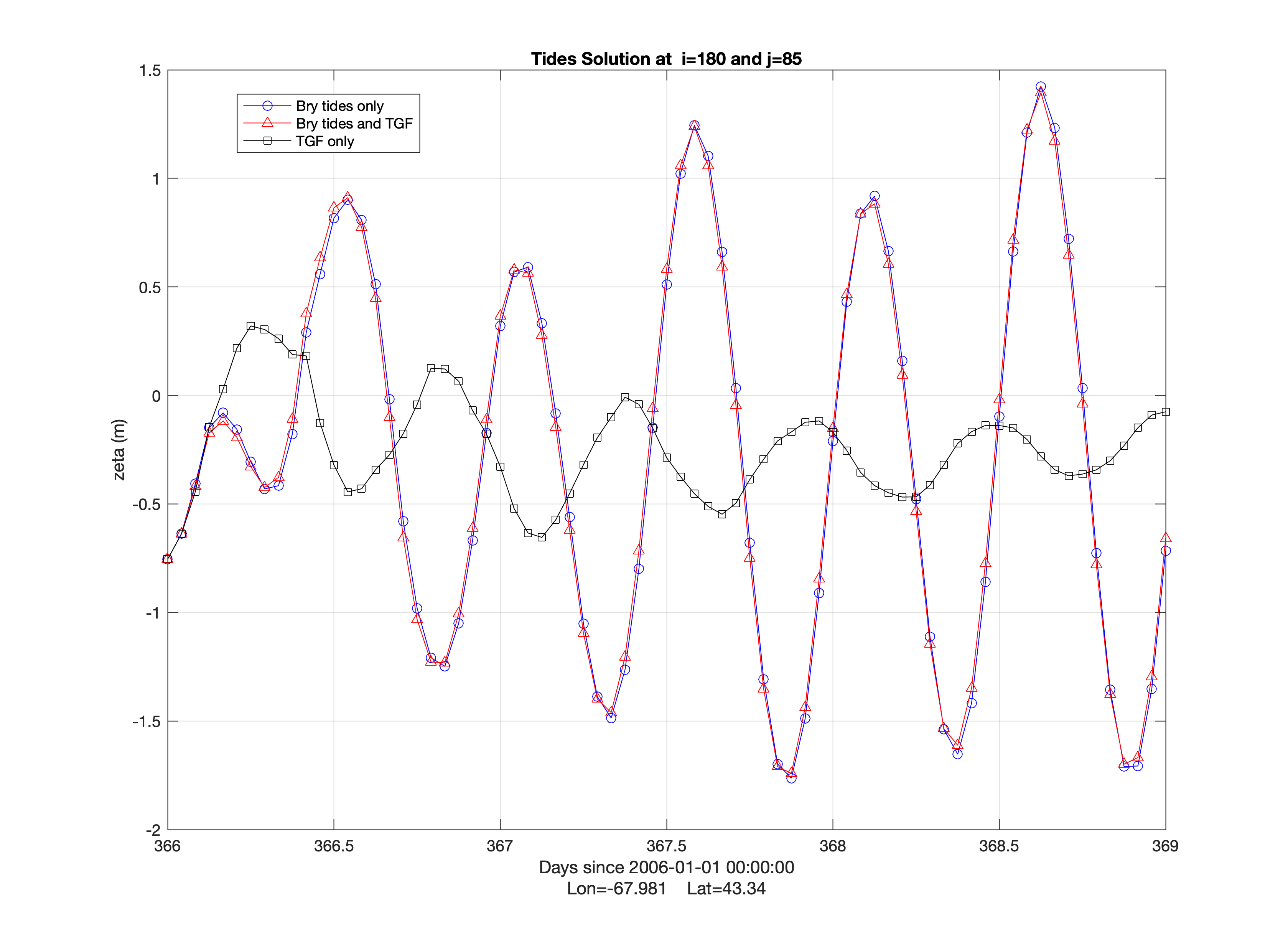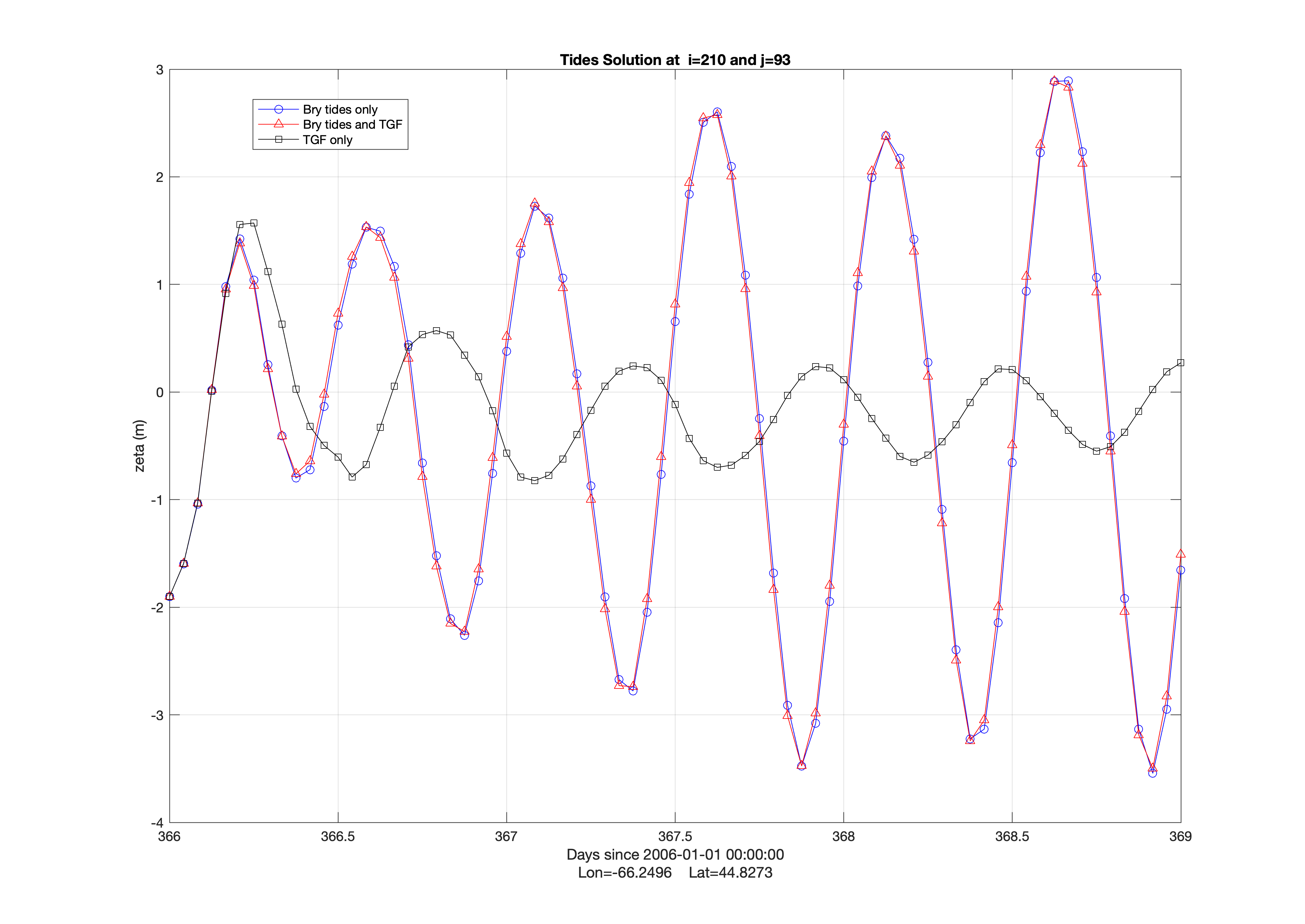#896 closed upgrade (Done)
VERY IMPORTANT: Adding Tide Generating Forces (TGF) — at Version 2
| Reported by: | arango | Owned by: | |
|---|---|---|---|
| Priority: | major | Milestone: | Release ROMS/TOMS 4.0 |
| Component: | Nonlinear | Version: | 3.9 |
| Keywords: | Cc: |
Description (last modified by )
I implemented the astronomical Tide Generating Forces (TGF) in ROMS 2D and 3D pressure gradient routines. They are coded in terms of the equilibrium tide (ζeq), defined as the shape that the sea surface (m) would assume if it were motionless and in equilibrium with the TGF on a fluid plane (Arbic et al., 2018).
It is activated with the option TIDE_GENERATING_FORCES. It is restricted to spherical grids since we need (lon, lat) of every cell to compute the harmonic constituents parameters for the location of the Moon and Sun. We recommend activating this option in conjunction with boundary tidal forcing (SSH_TIDES and UV_TIDES).
Thanks to John Wilkin for writing the implementation documentation (including equations and harmonics) and the Matlab scripts to compute the equilibrium tide offline and examine the harmonic parameters. Basically, the pressure gradient terms are of the form:
-g (∂(ζ - ζeq))/∂x
-g (∂(ζ - ζeq))/∂y
where g is the acceleration due to gravity (m/s2), ζ is the surface elevation (m), and ζeq is the equilibrium tide (m).
During its implementation, I examined and tested the 3D and 2D pressure gradient algorithms in ROMS. I discovered a but in prsgrd32.h (activated with DJ_GRADPS). This issue is discussed in detail in following forum post.
Two new routines were added:
- ROMS/Utility/equilibrium_tide.F: module containing routines to compute the equilibrium tide (equilibrium_tide) at every timestep and the harmonic constituents parameters (harmonic_constituents) once during initialization. The equilibrium tide is save in state variable OCEAN(ng)%eq_tide.
- ROMS/Utility/tides_date.F: Routine to checkout the input time reference parameter TIDE_START, defined as the time of phase zero when preparing the input tidal boundary data NetCDF file specified in TIDENAME.
Currently, there are two ways to specify the tide_start ROMS variable in an application:
(1) Set the zero_phase_date variable in the input tidal forcing NetCDF file (recommended). It a floating-point variable of the form YYYYMMDD.dddd with the following NetCDF metadata:
variables: double zero_phase_date ; zero_phase_date:long_name = "tidal reference date for zero phase" ; zero_phase_date:units = "days as %Y%m%d.%f" ; zero_phase_date:C_format = "%13.4f" ; zero_phase_date:FORTRAN_format = "(f13.4)" ;
For example, if the tide reference date is 2005-01-01 12:00:00, the zero_phase_date = 20050101.5000:
data: zero_phase_date = 20060101.0000 ;Again, it corresponds to the zero tidal phase when preparing the forcing NetCDF file from the tides dataset (say, OTPS).
Use script forcing/add_tide_date.m from the ROMS Matlab repository to add the zero_phase_date variable to your existing tidal forcing NetCDF file:
>> add_tide_date('my_frc_tides.nc', datenum(2006,1,1))
It is highly recommended to use this approach. If such a variable is found, the TIDE_START value will be overwritten.
Notice that it is possible to have different reference values for zero_phase_date and ROMS clock defined as seconds from reference date (standard input parameter TIME_REF). If ROMS variable time_ref is earlier than zero_phase_date, the frequencies (omega) to harmonic terms will be negative since they are computed as follows:
tide_start = Rclock%tide_DateNumber(2) - Rclock%DateNumber(2)) omega = 2 * pi * (time - tide_start) / TperiodNotice that tide_start (in seconds) is recomputed, and the value specified in the input standard file is ignored.
If the variable zero_phase_date is found, ROMS will report to standard output:
TIDES_DATE - Checking tidal reference date for zero phase: zero_phase_date = 20060101.0000 (read from ../../../om/doppio_tide_7km.nc) tide_DateNumber = 732678.0000 (2006-01-01 00:00:00) old tide_start = 0.0000 (days) new tide_start = 0.0000 (days)
(2) The specify TIDE_START in the ROMS standard input file as days from the application reference time (TIME_REF) is used it the variable zero_phase_date is not found in the NetCDF file. In the input standard input file we have:
TIDE_START = 0.0d0 ! days TIME_REF = 20060101.0d0 ! yyyymmdd.ddUsually, tide_start = 0 implies that the zero-phase tidal forcing date is the same as the application reference date time_ref. ROMS does not know how to check if it is the case. Thus, it is assumed that the user was careful when configuring their application.
In this case, ROMS will report to standard output:
TIDES_DATE - Checking tidal reference date for zero phase:
'zero_phase_date' variable not found in ../../../om/doppio_tide_7km.nc)
given tide_start = 0.0000 (days)
tide_DateNumber = 732678.0000 (2006-01-01 00:00:00)
This capability was also added to the ADM, TLM, and RPM pressure gradient routines. However, I noticed that it slows the 4D-Var algorithm convergence. I need to test in other applications.
I look forward to advanced users helping us test the TGF implementation in their tide forced applications.
Below are two figures that show the sea surface elevation in the center of the Gulf of Maine (top) and at the entrance of the Bay of Fundi (bottom). ROMS is configured with boundary tidal forcing, tide generating force, and inverted barometer effect in the pressure gradient.
As expected, the TGF makes very small corrections to the boundary tidal forcing. It implies that the tide boundary forcing is well calibrated for this application. Users will need to activate both tidal forcings (SSH_TIDES, UV_TIDES, TIDE_GENERATING_FORCES). The ATM_PRESS is activated for all solutions.
WARNINGS:
- All the standard input files (roms_*.in) in the repositories were modified to add the Lnodal input switch for the TGF harmonics:
! If tide generating forces, set switch (T/F) to apply an 18.6-year lunar ! nodal correction to equilibrium tide constituents. Lnodal = T
- The file varinfo.dat was updated to include the zero_phase_date metadata:
'zero_phase_date' ! Input 'tidal reference date for zero phase' 'days as %Y%m%d.%f' ! YYYYMMDD.dddd 'nulvar' 'nulvar' 'idTref' 'nulvar' 1.0d0
References:
Arbic, B.K., Garner, S.T., Hallberg, R.W. and Simmons, H.L., 2004: The accuracy of surface elevations in forward global barotropic and baroclinic tide models, Deep Sea Research Part II: Topical Studies in Oceanography, 51(25-26), pp. 3069-3101.
Arbic, B.K., Alford, M.H., Ansong, J.K., Buijsman, M.C., Ciotti, R.B., Farrar, J.T., Hallberg, R.W., Henze, C.E., Hill, C.N., Luecke, C.A. and Menemenlis, D., 2018: Primer on Global Internal Tide and Internal Gravity Wave Continuum Modeling in HYCOM and MITgcm. In: New Frontiers in Operational Oceanography, E. Chassignet, A. Pascual, J. Tintoré and J. Verron (Eds.), GODAE OceanView, 307-392, doi: 10.17125/gov2018.ch13
Doodson, A.T. and Warburg, H.D., 1941: Admiralty Manual of Tides. His Majesty’s Stationery Office, London, UK, 270 pp.
Egbert, G.D. and Ray, R.D., 2017: Tidal prediction, Journal of Marine Research, 75(3), pp.189-237.
Change History (2)
comment:1 by , 3 years ago
| Description: | modified (diff) |
|---|---|
| Resolution: | → Done |
| Status: | new → closed |
comment:2 by , 3 years ago
| Description: | modified (diff) |
|---|


